2018 Honda CB1000R Test: Change of Universe
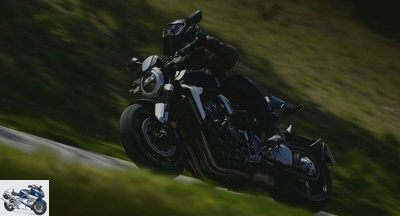
Ten after making headlines, the Honda CB 1000 R is looking for a new style. Storing her modern influences in the closet, she plunges both wheels forward on the retro trend. Retro, but not too much, since the manufacturer announces an electronic unboxing in line with the increase in power and a reduced weight. Test.
CB1000R 2018 test – Page 3: Technical point
CB1000R 2018 engine
Descended from its debut of the CBR1000RR’s twin-shaft liquid 4-cylinder engine, the engine is gaining more power and torque this year. It delivers 145 hp at 10,500 rpm and 105 Nm at 8,250 rpm, while the previous one was worth 125 hp at 10,000 rpm and 99 Nm at 7,750 rpm. The red zone is fixed at 11,500 rev / min, the breaker intervening 500 revolutions higher. Pistons, now forged, increase compression ratio by 0.4 to the benefit of torque.
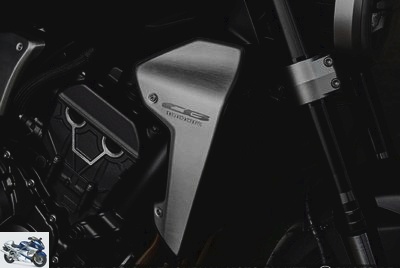
Better flow of gas flow, increased valve lift, larger diameter injector bodies (from 36 to 44 mm) and revised combustion chambers contribute to the better performance of this engine whose new gearbox and its modified air intakes aim to reduce the pressure losses of the forced inlet. To improve acceleration between 30 and 130 km / h, the transmission features a 4% reduction in gearbox ratios and the new assisted slip clutch offers more smoothness at the lever.
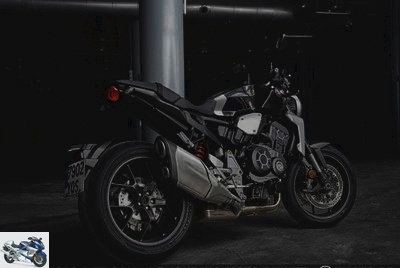
While it has gained volume, the new 4-2-1 exhaust system remains aesthetically pleasing. Weighing only 11.2 kg, it contributes, according to Honda, to mid-range performance, but above all to weight reduction (- 4.5 kg). Its four small catalysts arranged in a main chamber feed a double chamber silencer, a trigger guard associating the two main tubes just before the catalysts to optimize torque beyond 5,000 rpm.
2018 CB1000R chassis
Always adjustable in hydraulic preload, compression and rebound, the Showa Separate Function Front Fork Big Piston (SFF-BP) inverted fork houses all damping functions in a single tube to reduce weight. The mono shock absorber also signed Showa is adjustable in preload, compression, and rebound.
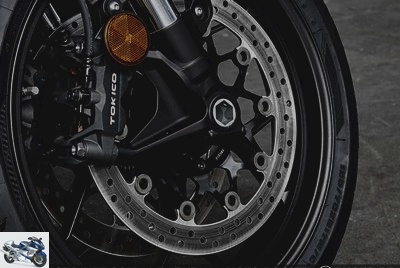
Braking, associated with an ABS, is entrusted to Tokico 4 pistons with radial fixing which cover floating tracks of 310 mm. At the rear we can count on a single 256 mm disc and a double piston caliper. The rear tire in 190/55 ZR17 (against 180/55 previously) is installed on a 6-inch rim. 10-spoke aluminum rims offer a new design.
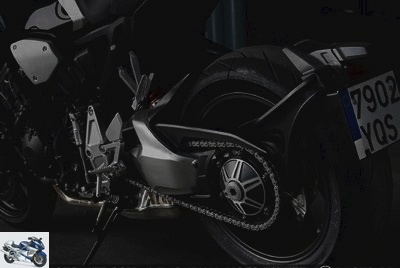
The CB1000R abandons its frame type "mono-backbone" (single beam) in aluminum for a steel element, like that of the late Hornet 900. To those who consider that it is a step backwards, the engineers answer that this choice has allowed to "better manage the torsions". We will not know more … Aluminum side plates, 2.5 kg lighter, fix a single-arm sculptural, of the same metal and certainly very rigid, 14.7 mm shorter than that of the previous generation.
The hunting angle does not change. However, the total length of the motorcycle lengthens by 10 millimeters. With 212 kg in running order, the 2018 CB 1000 R is 12 kg lighter than the old one. Weight saved on the frame, fittings and exhaust. The weight distribution between front and rear is 48.5% / 51.5%.
Good news: the "triangle" which determines the driving position is more open than before, with a handlebars 12 mm wider and placed 13 mm higher than on the old version. On the other hand, the saddle is higher by 5 mm (830 mm).
CB1000R 2018 electronics
Honda has adopted for this CB1000R an electronic Throttle By Wire (TBW) accelerator to manage the pre-programmed driving modes, accessible to the left stalk, in addition to an "à la carte" mode, User.
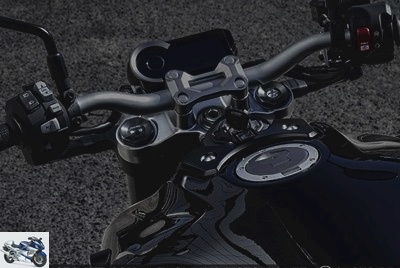
There are three possible settings for power (P), engine brake (EB) and the intervention of the HSTC (Honda Selectable Torque Control) torque control system, which can also be deactivated. The three pre-programmed driving modes offer different combinations of each of these parameters:
- Rain mode retains the lowest power level, an intermediate engine brake setting and a high level of HSTC intervention. Power and torque limitation is concentrated in the first three gears.
- Standard mode offers an intermediate power level for horsepower, torque control and engine braking. In detail, the power is limited in the first 2 reports, a torque contained when the throttle is not fully open and a power curve close to that of Sport mode. This set allows some sliding from the rear and slight shedding of the front wheel.
- Sport mode unleashes all performance with minimal intervention on engine braking and torque control. Power is available at 100% in all gears and maximum torque regardless of the throttle opening.
- Finally, User mode allows the pilot to choose between three settings on each of the parameters and to save his preferences..
In the upper right corner of the screen, the instrumentation displays a gear change aid indicator which flashes white with increasing frequency when the rpm exceeds the preset value or gradually changes from yellow to amber then pink to guide visually the pilot in his upshifts. Optionally, the same space can also display the ECO driving indicator, the driving mode indicator or the engaged gear indicator.
Related articles
-
2020 Z650 test: the Kawasaki roadster not all new but all beautiful ? Launched in 2017 on the competitive medium-displacement roadster market, the…
-
Roadster – Test Honda CB1000R 2018: change of universe – Test CB1000R 2018 – Page 4: Technical sheet
2018 Honda CB1000R Test: Change of Universe Ten after making headlines, the Honda CB 1000 R is looking for a new style . Putting her modern influences in…
-
2018 BMW F 750 GS and F 850 GS test: which one to choose ? In 2018, the BMW F750GS and F850GS gain in displacement and technology to succeed the F700GS…
-
Honda CBR1000RR / SP 2017 test: neither gross nor submitted ! Forget the old CBR1000RR lacking in performance and technology: Honda celebrates 25 years…
-
2018 Honda Goldwing Touring test: more watts, less cotton wool On an exceptional motorcycle, exceptional measures: after 17 years without major…
-
2018 Honda Goldwing Touring test: more watts, less cotton wool On an exceptional motorcycle, exceptional measures: after 17 years without major…
-
2018 Triumph Tiger 800 XCA and XRT test: smart vision Does the imposing Triumph Tiger 1200 intimidate you? Opt for the Tiger 800 2018: more accessible…
-
Roadster – Test Honda CB1000R 2018: change of universe – Test CB1000R 2018 – Page 1: Static
2018 Honda CB1000R Test: Change of Universe Ten after making headlines, the Honda CB 1000 R is looking for a new style. Putting her modern influences in…
-
Duel Honda CB1000R 2018 Vs Triumph Speed Triple RS: chic duo for shock duel Two new maxiroadsters land in 2018: the CB1000R, eagerly awaited by Honda…
-
2019 Honda Forza 300 review: more sport, less comfort Modeled on the bestseller 125, the new Honda Forza 300 radically evolves towards more dynamism….